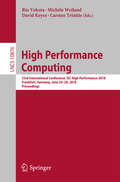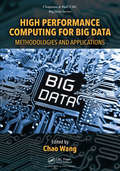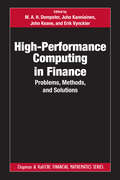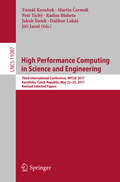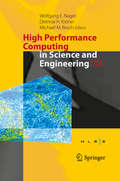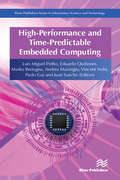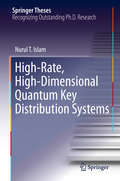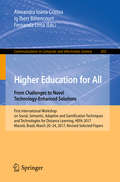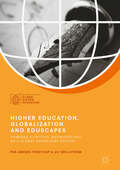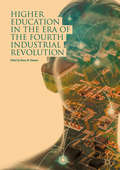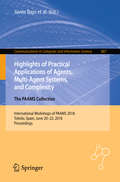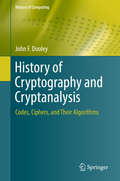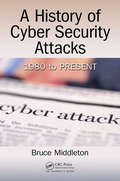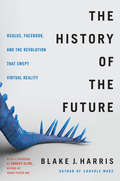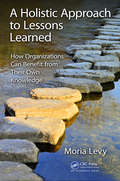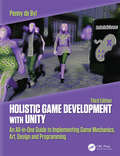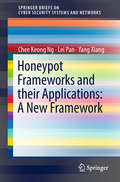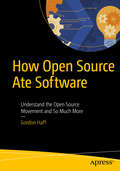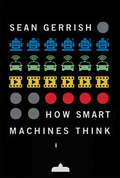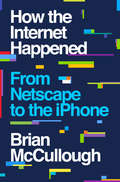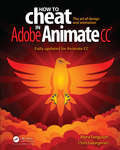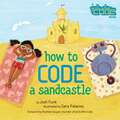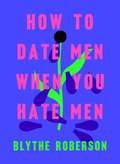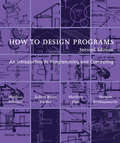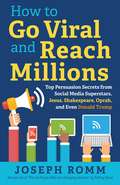- Table View
- List View
High Performance Computing: 33rd International Conference, ISC High Performance 2018, Frankfurt, Germany, June 24-28, 2018, Proceedings (Lecture Notes in Computer Science #10876)
by Rio Yokota Michèle Weiland David Keyes Carsten TrinitisThis book constitutes the refereed proceedings of the 33rd International Conference, ISC High Performance 2018, held in Frankfurt, Germany, in June 2018. The 20 revised full papers presented in this book were carefully reviewed and selected from 81 submissions. The papers cover the following topics: Resource Management and Energy Efficiency; Performance Analysis and Tools; Exascale Networks; Parallel Algorithms.
High Performance Computing for Big Data: Methodologies and Applications (Chapman & Hall/CRC Big Data Series)
by Chao WangHigh-Performance Computing for Big Data: Methodologies and Applications explores emerging high-performance architectures for data-intensive applications, novel efficient analytical strategies to boost data processing, and cutting-edge applications in diverse fields, such as machine learning, life science, neural networks, and neuromorphic engineering. The book is organized into two main sections. The first section covers Big Data architectures, including cloud computing systems, and heterogeneous accelerators. It also covers emerging 3D IC design principles for memory architectures and devices. The second section of the book illustrates emerging and practical applications of Big Data across several domains, including bioinformatics, deep learning, and neuromorphic engineering. Features Covers a wide range of Big Data architectures, including distributed systems like Hadoop/Spark Includes accelerator-based approaches for big data applications such as GPU-based acceleration techniques, and hardware acceleration such as FPGA/CGRA/ASICs Presents emerging memory architectures and devices such as NVM, STT- RAM, 3D IC design principles Describes advanced algorithms for different big data application domains Illustrates novel analytics techniques for Big Data applications, scheduling, mapping, and partitioning methodologies Featuring contributions from leading experts, this book presents state-of-the-art research on the methodologies and applications of high-performance computing for big data applications. About the Editor Dr. Chao Wang is an Associate Professor in the School of Computer Science at the University of Science and Technology of China. He is the Associate Editor of ACM Transactions on Design Automations for Electronics Systems (TODAES), Applied Soft Computing, Microprocessors and Microsystems, IET Computers & Digital Techniques, and International Journal of Electronics. Dr. Chao Wang was the recipient of Youth Innovation Promotion Association, CAS, ACM China Rising Star Honorable Mention (2016), and best IP nomination of DATE 2015. He is now on the CCF Technical Committee on Computer Architecture, CCF Task Force on Formal Methods. He is a Senior Member of IEEE, Senior Member of CCF, and a Senior Member of ACM.
High-Performance Computing in Finance: Problems, Methods, and Solutions (Chapman and Hall/CRC Financial Mathematics Series)
by M. A. H. Dempster, Juho Kanniainen, John Keane and Erik VynckierHigh-Performance Computing (HPC) delivers higher computational performance to solve problems in science, engineering and finance. There are various HPC resources available for different needs, ranging from cloud computing– that can be used without much expertise and expense – to more tailored hardware, such as Field-Programmable Gate Arrays (FPGAs) or D-Wave’s quantum computer systems. High-Performance Computing in Finance is the first book that provides a state-of-the-art introduction to HPC for finance, capturing both academically and practically relevant problems.
High Performance Computing in Science and Engineering: Third International Conference, HPCSE 2017, Karolinka, Czech Republic, May 22–25, 2017, Revised Selected Papers (Lecture Notes in Computer Science #11087)
by Tomáš Kozubek Martin Čermák Petr Tichý Radim Blaheta Jakub Šístek Dalibor Lukáš Jiří JarošThis book constitutes the thoroughly refereed post-conference proceedings of the Third International Conference on High Performance Computing in Science and Engineering, HPCSE 2017, held in Karolinka, Czech Republic, in May 2017.The 15 papers presented in this volume were carefully reviewed and selected from 20 submissions. The conference provides an international forum for exchanging ideas among researchers involved in scientific and parallel computing, including theory and applications, as well as applied and computational mathematics. The focus of HPCSE 2017 was on models, algorithms, and software tools which facilitate efficient and convenient utilization of modern parallel and distributed computing architectures, as well as on large-scale applications.
High Performance Computing in Science and Engineering ' 17
by Wolfgang E. Nagel Dietmar H. Kröner Michael M. ReschThis book presents the state-of-the-art in supercomputer simulation. It includes the latest findings from leading researchers using systems from the High Performance Computing Center Stuttgart (HLRS) in 2017. The reports cover all fields of computational science and engineering ranging from CFD to computational physics and from chemistry to computer science with a special emphasis on industrially relevant applications. Presenting findings of one of Europe’s leading systems, this volume covers a wide variety of applications that deliver a high level of sustained performance.The book covers the main methods in high-performance computing. Its outstanding results in achieving the best performance for production codes are of particular interest for both scientists and engineers. The book comes with a wealth of color illustrations and tables of results.
High Performance Embedded Computing
by Luís Miguel Pinho Eduardo Quiñones Marko Bertogna Andrea Marongiu Vincent Nélis Paolo Gai Juan SanchoNowadays, the prevalence of computing systems in our lives is so ubiquitous that we live in a cyber-physical world dominated by computer systems, from pacemakers to cars and airplanes. These systems demand for more computational performance to process large amounts of data from multiple data sources with guaranteed processing times. Actuating outside of the required timing bounds may cause the failure of the system, being vital for systems like planes, cars, business monitoring, e-trading, etc. High-Performance and Time-Predictable Embedded Computing presents recent advances in software architecture and tools to support such complex systems, enabling the design of embedded computing devices which are able to deliver high-performance whilst guaranteeing the application required timing bounds. Technical topics discussed in the book include: Parallel embedded platforms Programming models Mapping and scheduling of parallel computations Timing and schedulability analysis Runtimes and operating systemsThe work reflected in this book was done in the scope of the European project P SOCRATES, funded under the FP7 framework program of the European Commission. High-performance and time-predictable embedded computing is ideal for personnel in computer/communication/embedded industries as well as academic staff and master/research students in computer science, embedded systems, cyber-physical systems and internet-of-things.
High-Rate, High-Dimensional Quantum Key Distribution Systems (Springer Theses)
by Nurul T. IslamThis book describes a broad research program on quantum communication. Here, a cryptographic key is exchanged by two parties using quantum states of light and the security of the system arises from the fundamental properties of quantum mechanics. The author developed new communication protocols using high-dimensional quantum states so that more than one classical bit is transferred by each photon. This approach helps circumvent some of the non-ideal properties of the experimental system, enabling record key rates on metropolitan distance scales. Another important aspect of the work is the encoding of the key on high-dimensional phase-randomized weak coherent states, combined with so-called decoy states to thwart a class of possible attacks on the system. The experiments are backed up by a rigorous security analysis of the system, which accounts for all known device non-idealities. The author goes on to demonstrate a scalable approach for increasing the dimension of the quantum states, and considers attacks on the system that use optimal quantum cloning techniques. This thesis captures the current state-of-the-art of the field of quantum communication in laboratory systems, and demonstrates that phase-randomized weak coherent states have application beyond quantum communication.
Higher Education for All. From Challenges to Novel Technology-Enhanced Solutions: First International Workshop On Social, Semantic, Adaptive And Gamification Techniques And Technologies For Distance Learning, Hefa 2017, Maceió, Brazil, March 20-24, 2017, Revised Selected Papers (Communications In Computer And Information Science #832)
by Alexandra Ioana Cristea Ig Ibert Bittencourt Fernanda LimaThis book constitutes the thoroughly refereed proceedings of the Researcher Links Workshop: Higher Education for All, held in Maceió, Brazil, in March 2017. The 12 full papers presented were carefully reviewed and selected from 31 submissions. The papers deal with a large spectrum of topics, including higher education, technology-enhanced solutions, user modelling, user grouping, gamification, educational games, MOOCs, e-learning, open educational resources, collaborative learning, student modelling, serious games, language analysis.
Higher Education, Globalization and Eduscapes: Towards A Critical Anthropology Of A Global Knowledge Society (Palgrave Studies in Global Higher Education)
by Per-Anders Forstorp Ulf MellströmThis book examines transnational scapes and flows of higher education: arguing that the educational and political vision of a national, regional and global knowledge society needs to be perspectivized beyond its ethnocentric conditions and meanings. Using eduscapes as its most important concept, this book explores the educational landscapes of individual as well as institutional actors; particularly the agential aspects of how global eduscapes are imagined, experienced, negotiated and constructed. In addition, the authors highlight the critical potential of anthropology, using this perspective as a resource for cultural critique where the Western experience and assumed ‘ownership’ of the global knowledge economy will be put into question. This comprehensive book will appeal to students and scholars of educational policy, the sociology of education and the globalization of education.
Higher Education in the Era of the Fourth Industrial Revolution
by Nancy W. GleasonThis open access collection examines how higher education responds to the demands of the automation economy and the fourth industrial revolution. Considering significant trends in how people are learning, coupled with the ways in which different higher education institutions and education stakeholders are implementing adaptations, it looks at new programs and technological advances that are changing how and why we teach and learn. The book addresses trends in liberal arts integration of STEM innovations, the changing role of libraries in the digital age, global trends in youth mobility, and the development of lifelong learning programs. This is coupled with case study assessments of the various ways China, Singapore, South Africa and Costa Rica are preparing their populations for significant shifts in labour market demands – shifts that are already underway. Offering examples of new frameworks in which collaboration between government, industry, and higher education institutions can prevent lagging behind in this fast changing environment, this book is a key read for anyone wanting to understand how the world should respond to the radical technological shifts underway on the frontline of higher education.
Highlights of Practical Applications of Agents, Multi-Agent Systems, and Complexity: International Workshops of PAAMS 2018, Toledo, Spain, June 20–22, 2018, Proceedings (Communications in Computer and Information Science #887)
by Javier Bajo Juan M. Corchado Elena María Navarro Martínez Eneko Osaba Icedo Philippe Mathieu Patrycja Hoffa-Dąbrowska Elena Del Val Sylvain Giroux Antonio J. M. Castro Nayat Sánchez-Pi Vicente Julián Ricardo Azambuja Silveira Alberto Fernández Rainer Unland Rubén Fuentes-FernándezThis book constitutes the refereed proceedings of the 11 workshops co-located with the 16th International Conference on Practical Applications of Agents and Multi-Agent Systems, PAAMS 2018, held in Toledo, Spain, in June 2018. The 47 full papers presented were carefully reviewed and selected from 72 submissions. The volume presents the papers that have been accepted for the following workshops: Workshop on Agents and Multi-agent Systems for AAL and e-HEALTH; Workshop on Agent based Applications for Air Transport; Workshop on Agent-based Artificial Markets Computational Economics; Workshop on Agent-Based Solutions for Manufacturing and Supply Chain; Workshop on MAS for Complex Networks and Social Computation; Workshop on Intelligent Systems and Context Information Fusion; Workshop on Multi-agent based Applications for Energy Markets, Smart Grids and Sustainable Energy Systems; Workshop on Multiagent System based Learning Environments; Workshop on Smart Cities and Intelligent Agents; Workshop on Swarm Intelligence and Swarm Robotics; Workshop on Multi-Agent Systems and Simulation.
History of Cryptography and Cryptanalysis: Codes, Ciphers, and Their Algorithms (History of Computing)
by John F. DooleyThis accessible textbook presents a fascinating review of cryptography and cryptanalysis across history. The text relates the earliest use of the monoalphabetic cipher in the ancient world, the development of the “unbreakable” Vigenère cipher, and an account of how cryptology entered the arsenal of military intelligence during the American Revolutionary War. Moving on to the American Civil War, the book explains how the Union solved the Vigenère ciphers used by the Confederates, before investigating the development of cipher machines throughout World War I and II. This is then followed by an exploration of cryptology in the computer age, from public-key cryptography and web security, to criminal cyber-attacks and cyber-warfare. Looking to the future, the role of cryptography in the Internet of Things is also discussed, along with the potential impact of quantum computing.Topics and features: presents a history of cryptology from ancient Rome to the present day, with a focus on cryptology in the 20th and 21st centuries; reviews the different types of cryptographic algorithms used to create secret messages, and the various methods for breaking such secret messages; provides engaging examples throughout the book illustrating the use of cryptographic algorithms in different historical periods; describes the notable contributions to cryptology of Herbert Yardley, William and Elizebeth Smith Friedman, Lester Hill, Agnes Meyer Driscoll, and Claude Shannon; concludes with a review of tantalizing unsolved mysteries in cryptology, such as the Voynich Manuscript, the Beale Ciphers, and the Kryptos sculpture.This engaging work is ideal as both a primary text for courses on the history of cryptology, and as a supplementary text for advanced undergraduate courses on computer security. No prior background in mathematics is assumed, beyond what would be encountered in an introductory course on discrete mathematics.
A History of Cyber Security Attacks: 1980 to Present
by Bruce MiddletonStories of cyberattacks dominate the headlines. Whether it is theft of massive amounts of personally identifiable information or the latest intrusion of foreign governments in U.S. government and industrial sites, cyberattacks are now important. For professionals and the public, knowing how the attacks are launched and succeed is vital to ensuring cyber security. The book provides a concise summary in a historical context of the major global cyber security attacks since 1980. Each attack covered contains an overview of the incident in layman terms, followed by a technical details section, and culminating in a lessons learned and recommendations section.
The History of the Future: Oculus, Facebook, and the Revolution That Swept Virtual Reality
by Blake J. HarrisThe dramatic, larger-than-life true story behind the founding of Oculus and its quest for virtual reality, by the bestselling author of Console Wars. Drawing on over a hundred interviews with the key players driving this revolution, The History of the Future weaves together a rich, cinematic narrative that captures the breakthroughs, breakdowns and human drama of trying to change the world. The result is a super accessible and supremely entertaining look at the birth of a game-changing new industry.From iconic books like Neuromancer to blockbuster films like The Matrix, virtual reality has long been hailed as the ultimate technology. But outside of a few research labs and military training facilities, this tantalizing vision of the future was nothing but science fiction. Until 2012, when Oculus founder Palmer Luckey—then just a rebellious teenage dreamer living alone in a camper trailer—invents a device that has the potential to change everything. With the help of a videogame legend, a serial entrepreneur and many other colorful characters, Luckey’s scrappy startup kickstarts a revolution and sets out to bring VR to the masses. As with most underdog stories, things don’t quite go according to plan. But what happens next turns out to be the ultimate entrepreneurial journey: a tale of battles won and lost, lessons learned and neverending twists and turns—including an unlikely multi-billion-dollar acquisition by Facebook’s Mark Zuckerberg, which shakes up the landscape in Silicon Valley and gives Oculus the chance to forever change our reality. Drawing on over a hundred interviews with the key players driving this revolution, The History of the Future weaves together a rich, cinematic narrative that captures the breakthroughs, breakdowns and human drama of trying to change the world. The result is a super accessible and supremely entertaining look at the birth of a game-changing new industry.
A Holistic Approach to Lessons Learned: How Organizations Can Benefit from Their Own Knowledge
by Moria LevyThe book presents a holistic approach to organization performance improvements by lessons learned management. Such an approach is required because specific methods, such as debriefing, task management or procedures updates, do not achieve actual improvements. The presented model spans the entire life cycle of lessons learned: Starting from creating new lessons, moving on to knowledge refining and ending with smart integration into the organizational environment so future re-use of knowledge is enabled. The model also addresses other sources of organizational learning including quality processes and employee experience utilization.
Holistic Game Development with Unity 3e: An All-in-One Guide to Implementing Game Mechanics, Art, Design and Programming
by Penny de BylMaster game design and digital art principles simultaneously with this all-in-one guide to creating games in the cutting-edge game engine Unity. Reworked for C# and Unity 2018 & 2019, and bursting with images and tutorials, Penny de Byl’s Holistic Game Development with Unity will help the reader gain the multidisciplinary skills needed to succeed in the independent game industry. Holistic Game Development with Unity includes new coverage on Augmented Reality, Networking, and Virtual Reality such as the Oculus Rift. Supplementary material, including instructional videos, discussion forums and art assets are provided in the companion website located at www.holistic3d.com. Learn to combine the beauty of art and the functionality of programming in de Byl’s third edition for Unity game development. Key features: Art and programming in Unity, the only one-stop shop for individual developers and small teams looking to tackle both tasks. Proven step-by-step tutorials show you how to design and structure an entire game in Unity with art assets. Revised to cover the Unity game engine versions 2018 and 2019. New coverage of Nav Meshes, Augmented Reality, Mobile Builds and Mecanim. An introduction to essential two- and three-dimensional mathematical and physics concepts. A portfolio of royalty free reusable game mechanics. Revamped and expanded accompanying website, www.holistic3d.com, features project source code, instructional videos, art assets, author blog, and discussion forums. Additional challenge questions and lesson plans are available online for an enhanced learning experience.
Honeypot Frameworks and Their Applications: A New Framework (SpringerBriefs on Cyber Security Systems and Networks)
by Yang Xiang Lei Pan Chee Keong NgThis book presents the latest research on honeypots and their applications. After introducing readers to the basic concepts of honeypots and common types, it reviews various honeypot frameworks such as web-server-based, client-based, shadow and artificially intelligent honeypots. In addition, it offers extensive information on the contribution of honeypots in some of the most popular malware research area such as DDoS, Worm, APT, forensics and Bot attacks. The book subsequently tackles the issue of honeypot countermeasures, shows many of the tricks often used by hackers to discover honeypots, and proposes a counter-countermeasure to help conceal them. It then puts forward a new framework that integrates various novel concepts, and which can feasibly be used for the detection of potential ransomware and bitcoin. As such, the book provides non-experts with a concise guide to honeypots, and will also benefit practitioners working on security systems.
How Open Source Ate Software: Understand The Open Source Movement And So Much More
by Gordon HaffLearn how free software became open source and how you can sell open source software. This book provides a historical context of how open source has thoroughly transformed how we write software, how we cooperate, how we communicate, how we organize, and, ultimately, how we think about business values.You’ll look at project and community examples including Linux, BSD, Apache, and Kubernetes, understand the open source development model, and how open source has influenced approaches more broadly, even proprietary software, such as open betas. You'll also examine the flipside, the "Second Machine Age," and the challenges of open source-based business models.Today, open source serves as shorthand for much broader trends and behaviors. It’s not just about a free (in all senses of the word) alternative to commercial software. It increasingly is the new commercial software. How Open Source Ate Software reveals how open source has much in common, and is often closely allied, with many other trends in business and society. You'll see how it enables projects that go beyond any individual company. That makes open source not just a story about software, but a story about almost everything.What You'll LearnUnderstand open source opportunities and challengesSell software if you’re giving it awayApply open source principles more broadly to openorg, devops, etc.Review which organizational incentives you can implement Who This Book Is ForAnyone who has an interest in what is happening in open source and the open source community, and anyone who is contemplating making a business that involves open source.
How Smart Machines Think (The\mit Press Ser.)
by Sean GerrishEverything you've always wanted to know about self-driving cars, Netflix recommendations, IBM's Watson, and video game-playing computer programs.The future is here: Self-driving cars are on the streets, an algorithm gives you movie and TV recommendations, IBM's Watson triumphed on Jeopardy over puny human brains, computer programs can be trained to play Atari games. But how do all these things work? In this book, Sean Gerrish offers an engaging and accessible overview of the breakthroughs in artificial intelligence and machine learning that have made today's machines so smart.Gerrish outlines some of the key ideas that enable intelligent machines to perceive and interact with the world. He describes the software architecture that allows self-driving cars to stay on the road and to navigate crowded urban environments; the million-dollar Netflix competition for a better recommendation engine (which had an unexpected ending); and how programmers trained computers to perform certain behaviors by offering them treats, as if they were training a dog. He explains how artificial neural networks enable computers to perceive the world—and to play Atari video games better than humans. He explains Watson's famous victory on Jeopardy, and he looks at how computers play games, describing AlphaGo and Deep Blue, which beat reigning world champions at the strategy games of Go and chess. Computers have not yet mastered everything, however; Gerrish outlines the difficulties in creating intelligent agents that can successfully play video games like StarCraft that have evaded solution—at least for now. Gerrish weaves the stories behind these breakthroughs into the narrative, introducing readers to many of the researchers involved, and keeping technical details to a minimum. Science and technology buffs will find this book an essential guide to a future in which machines can outsmart people.
How the Internet Happened: From Netscape To The Iphone
by Brian McCulloughTech-guru Brian McCullough delivers a rollicking history of the internet, why it exploded, and how it changed everything. The internet was never intended for you, opines Brian McCullough in this lively narrative of an era that utterly transformed everything we thought we knew about technology. In How the Internet Happened, he chronicles the whole fascinating story for the first time, beginning in a dusty Illinois basement in 1993, when a group of college kids set off a once-in-an-epoch revolution with what would become the first “dotcom.” Depicting the lives of now-famous innovators like Netscape’s Marc Andreessen and Facebook’s Mark Zuckerberg, McCullough also reveals surprising quirks and unknown tales as he tracks both the technology and the culture around the internet’s rise. Cinematic in detail and unprecedented in scope, the result both enlightens and informs as it draws back the curtain on the new rhythm of disruption and innovation the internet fostered, and helps to redefine an era that changed every part of our lives.
How to Cheat in Adobe Animate CC (How To Cheat)
by Myra Ferguson Chris GeorgenesWould you rather take months to learn every tool, every feature, and every concept in Adobe Animate or start right now making your own creations with just a few steps? Myra Ferguson is teaming up with Chris Georgenes to help you create great animation, bring objects to life with cool motion effects, and enhance your productivity in Animate CC! How to Cheat in Adobe Animate CC is a goldmine of artistic inspiration, time-saving practical tips, and step-by-step walkthroughs. Let your sasquatch sunbathe, your coyote howl, and your lint spider see the light of day. With real-world projects and project source files, you can follow along and try for yourself. This book includes all NEW content and cheats for Animate CC, such as making cinemagraphs, creating a double exposure effect, speeding up the process of making real life doodles, simulating a bokeh effect, converting your documents to HTML5, and more. Key Features • Glimpse into the workflow of digital media and animation experts and apply practical techniques and tips to your own projects with source files, examples, and tutorials. • Learn a myriad of tricks based on real-life working methods to help you work faster and more efficiently with new features in Adobe Animate CC and the Creative Cloud. • Work from the problem to the solution to gain the best possible results from Animate.
How to Code a Sandcastle
by Josh FunkFrom the computer science nonprofit Girls Who Code comes this lively and funny story introducing kids to computer coding concepts.All summer, Pearl has been trying to build the perfect sandcastle, but out-of-control Frisbees and mischievous puppies keep getting in the way! Pearl and her robot friend Pascal have one last chance, and this time, they&’re going to use code to get the job done. Using fundamental computer coding concepts like sequences and loops, Pearl and Pascal are able to break down their sandcastle problem into small, manageable steps. If they can create working code, this could turn out to be the best beach day ever! With renowned computer science nonprofit Girls Who Code, Josh Funk and Sara Palacios use humor, relatable situations, and bright artwork to introduce kids to the fun of coding.
How to Date Men When You Hate Men
by Blythe RobersonFrom New Yorker and Onion writer and comedian Blythe Roberson, How to Date Men When You Hate Men is a comedy philosophy book aimed at interrogating what it means to date men within the trappings of modern society. Blythe Roberson’s sharp observational humor is met by her open-hearted willingness to revel in the ugliest warts and shimmering highs of choosing to live our lives amongst other humans. She collects her crushes like ill cared-for pets, skewers her own suspect decisions, and assures readers that any date you can mess up, she can top tenfold. And really, was that date even a date in the first place?With sections like Real Interviews With Men About Whether Or Not It Was A Date; Good Flirts That Work; Bad Flirts That Do Not Work; and Definitive Proof That Tom Hanks Is The Villain Of You’ve Got Mail, How to Date Men When You Hate Men is a one stop shop for dating advice when you love men but don't like them."With biting wit, Roberson explores the dynamics of heterosexual dating in the age of #MeToo"— The New York Times
How to Design Programs, second edition: An Introduction to Programming and Computing (The\mit Press Ser.)
by Matthias Felleisen Robert Bruce Findler Matthew Flatt Shriram KrishnamurthiA completely revised edition, offering new design recipes for interactive programs and support for images as plain values, testing, event-driven programming, and even distributed programming.This introduction to programming places computer science at the core of a liberal arts education. Unlike other introductory books, it focuses on the program design process, presenting program design guidelines that show the reader how to analyze a problem statement, how to formulate concise goals, how to make up examples, how to develop an outline of the solution, how to finish the program, and how to test it. Because learning to design programs is about the study of principles and the acquisition of transferable skills, the text does not use an off-the-shelf industrial language but presents a tailor-made teaching language. For the same reason, it offers DrRacket, a programming environment for novices that supports playful, feedback-oriented learning. The environment grows with readers as they master the material in the book until it supports a full-fledged language for the whole spectrum of programming tasks.This second edition has been completely revised. While the book continues to teach a systematic approach to program design, the second edition introduces different design recipes for interactive programs with graphical interfaces and batch programs. It also enriches its design recipes for functions with numerous new hints. Finally, the teaching languages and their IDE now come with support for images as plain values, testing, event-driven programming, and even distributed programming.
How to Go Viral and Reach Millions: Top Persuasion Secrets from Social Media Superstars, Jesus, Shakespeare, Oprah, and Even Donald Trump
by Joseph RommHow to Go Viral and Reach Millions is the first book to reveal all the latest secrets for consistently generating viral online content-words, images, or videos that are seen and shared by hundreds of thousands and eventually even millions of people, something Romm and his colleagues in three different organizations achieve routinely.
